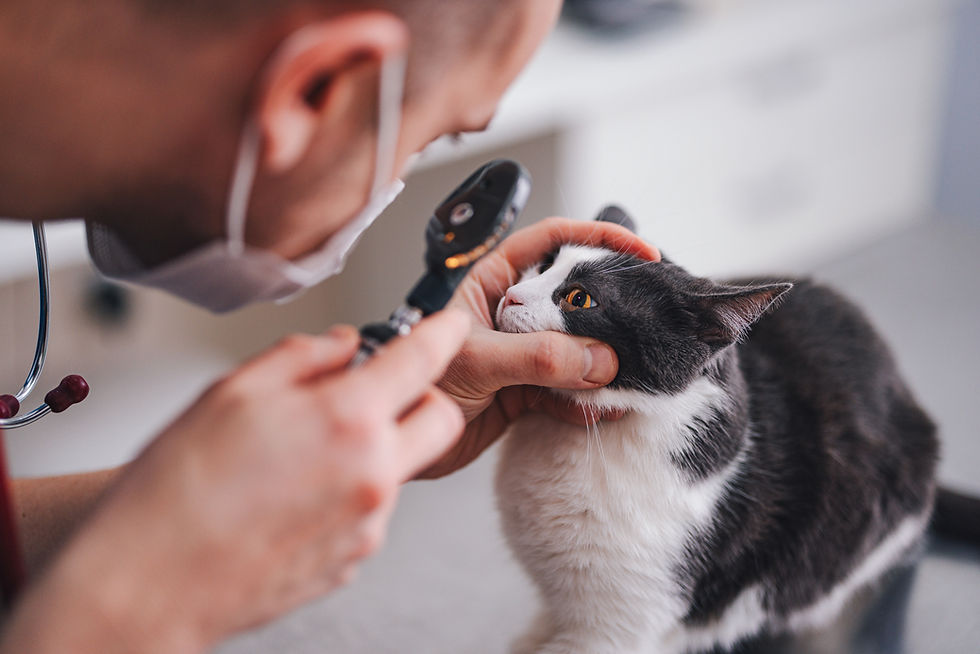Understanding Arthritis in Cats: What Every Owner Should Know
- Carolyn O'Brien
- May 20, 2024
- 3 min read
Arthritis, also known as osteoarthritis or degenerative joint disease, is a common condition in cats that involves inflammation and degeneration of one or more joints. It is particularly prevalent in older cats, with studies suggesting that up to 90% of cats over the age of 12 show some signs of the disease. However, arthritis can affect cats at any age, especially if predisposing factors include joint injury, abnormal joint development, obesity, or genetic predisposition.

Causes of Arthritis in Cats
Arthritis in cats can be caused by a variety of factors, including:
Wear and Tear: General wear and tear on the joints as cats age is a common cause
Injury: Joint injuries can lead to arthritis later in life
Genetic Predisposition: Certain breeds may be more prone to developing arthritis due to genetic factors. For example, Maine Coon cats are known to be at risk for hip dysplasia, which can lead to arthritis, and Scottish Fold cats have generalised cartilage issues leading to severe arthritis at an early age.
Obesity: Excess weight puts additional stress on a cat's joints, which can contribute to the development of arthritis
How do I know if my cat has arthritis?
Determining if your cat has arthritis can be challenging because cats are adept at hiding pain and discomfort. However, there are several signs and symptoms you can look for, as well as diagnostic steps that we can take to confirm the condition.
Take a look at the following video produced by Bohringer Ingelheim, the manufacturer of the popular anti-inflammatory drug, Metacam.
Reduced Mobility
Reluctance or hesitance to jump up or down: Cats with arthritis may avoid jumping or may only jump to lower surfaces than they used to.
Difficulty going up or down stairs
Stiffness in the legs: Especially noticeable after sleeping or resting.
Difficulty using the litter tray: Cats may struggle to get in and out of high-sided litter trays.
Limping or lameness: Although less common, some cats may show a stiff gait or limp.
Reduced Activity
Increased time spent resting or sleeping: Cats with arthritis may be less active and spend more time resting..
Less hunting or exploring: They may not engage in activities they used to enjoy.
Altered Grooming
Reduced grooming: This can lead to a matted or scruffy coat.
Overgrooming of painful joints: Some cats may excessively groom painful areas, leading to hair loss or skin issues.
Temperament Changes
Increased irritability or grumpiness: Cats may become more irritable when handled or stroked.
Avoiding interaction: They may spend more time alone and avoid contact with people or other animals.
Diagnostic Steps
Veterinary Examination
Physical examination: we check for pain, discomfort, swelling, or other changes in the joints.
X-rays: These can help confirm the diagnosis by showing changes in the joints, such as bone spurs or joint space narrowing.
Blood and urine tests: These may be conducted to rule out other conditions or to ensure the cat is healthy enough for certain treatments.
Management and Treatment
Home Modifications
Provide comfortable bedding: Ensure your cat has a warm, comfortable place to sleep away from drafts.
Use ramps or steps: Help your cat access favourite spots without jumping.
Low-sided litter trays: Make it easier for your cat to use the litter box.
Veterinary Treatments
Medications: Anti-inflammatory drugs (e.g. meloxicam), painkillers (e.g. tramadol), and newer treatments like monoclonal antibody (mAb) injections (e.g. Solensia) can help manage pain and improve mobility.
Weight management: Keeping your cat at a healthy weight can reduce stress on their joints.
Supplements: Glucosamine, chondroitin, and omega-3 fatty acids may support joint health.
Zoetis is the manufacturer of the breakthrough mAb, frunevetmab (Solensia), take a look at their video to see some typical responses to treatment:
While arthritis can be a challenging condition for cats, with proper care and management, you can help your furry friend maintain a good quality of life. Regular vet visits, a healthy lifestyle, and a few adjustments at home can make a significant difference in managing your cat’s arthritis. If you notice any signs of discomfort in your cat, don’t hesitate to reach out to us for advice and support.



